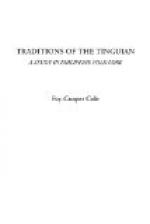[2] See page 29.
[3] The initial portion of some of these names is derived from the respectful term apo—“sir,” and the attributive copulate ni; thus the original form of Aponitolau probably was Apo ni Tolau, literally “Sir, who is Tolau.” However, the story-tellers do not now appear to divide the names into their component parts, and they frequently corrected the writer when he did so; for this reason such names appear in the text as single words. Following this explanation it is possible that the name Aponibolinayen may be derived from Apo ni bolan yan, literally “Sir (mistress) who is place where the moon”; but bolan generally refers to the space of time between the phases of the moon rather than to the moon itself. The proper term for moon is sinag, which we have seen is the mother of Gaygayoma—a star,—and is clearly differentiated from Aponibolinayen.
[4] [male]—male. [female]—female.
[5] Occasionally the storytellers become confused and give Pagbokasan as the father of Aponitolau.
[6] The town of Natpangan is several times mentioned as though it was the same as Kaodanan.
[7] Only the most important references found in the texts are given here. For a fuller list see the index.
[8] The only possible exception to this statement is the mention of a carabao sled on p. 150, and of Aponitolau and Aponibolinayen riding on a carabao p. 51.
[9] A term applied to any of the wilder head-hunting tribes.
[10] Ladders are placed on each side of the town gate and are inclined toward one another until they meet at the top. Returning warriors enter the village by climbing up the one and descending the other, never through the gate.
[11] Copper gongs.
[12] Sharpened bamboo poles which pass through the foramen magnum.
[13] This poison is placed in the food or drink. The use of poisoned darts or arrows seems never to have been known to this people.
[14] A similar custom is found among the Kayan of Borneo. See Hose and McDougall, Pagan Tribes of Borneo, Vol. II, p. 171 (London, 1912).
[15] In this dance a man and a woman enter the circle, each holding a cloth. Keeping time to the music, they approach each other with almost imperceptible movements of feet and toes, and a bending at the knees, meanwhile changing the position of the cloths. This is varied from time to time by a few quick, high steps. For fuller description see article by author in Philippine Journal of Science, Vol. III, No. 4, 1908, p. 208.
[16] The custom was formerly practised by the Ilocano. See Reyes, Folklore Filipino, p. 126 (Manila, 1899).
[17] See Philippine Journal of Science, Vol. III, No. 4, 1908, pp. 206, ff.
[18] The Tinguian do not have a classificatory system of relationship terms. The term kasinsin is applied alike to the children of mother’s and father’s brothers and sisters.




